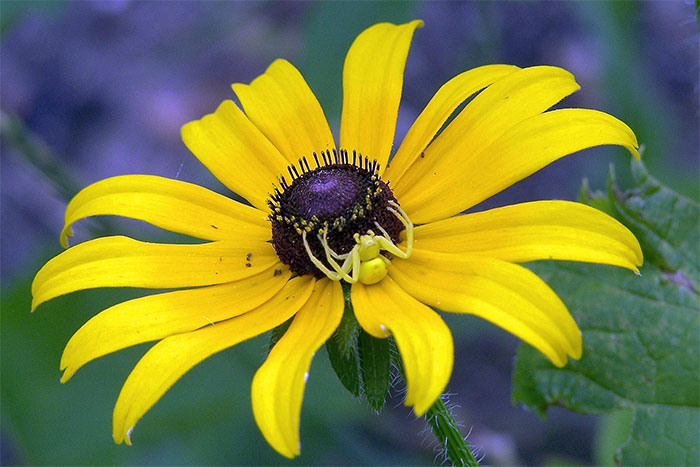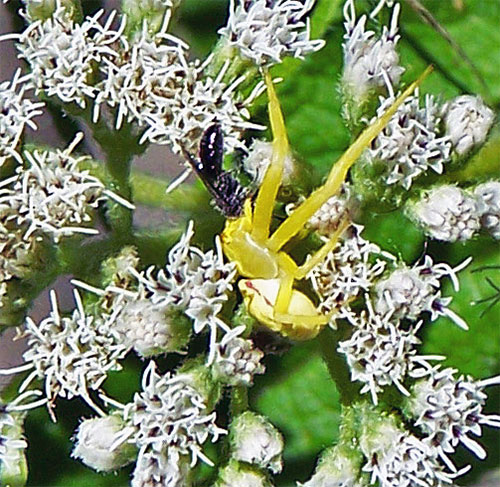Greetings, BugFans,
Today’s episode is a rerun/rewrite from the early days of BOTW. The BugLady is not on vacation, but she wishes she were.
Crab Spiders
The stars of this week’s episode are crab spiders, one of the Bug Lady’s (many) favorite “bugs.” They fit into the phylum Arthropoda (jointed legs) which consists of the Crustaceans, the Insects and the Arachnids, a pretty sizable chunk of the fauna of the world. Crab spiders are true spiders in the order Araneae, in the class Arachnida. In other words, Arachnids are under the big Arthropod “umbrella,” which shelters, among others, shrimp, crabs, sowbugs, spiders/spider relatives/mites/ticks, centipedes, millipedes, scorpions, and insects. Araneae—true spiders—are, in turn, under the Arachnid umbrella, (which is already under the Arthropod umbrella). They have 2 body segments—a cephalothorax and an abdomen—and 8 legs. Crab spiders are so named because they can sidle sideways or backwards across the flower tops with their front legs held like crab claws. There are about 200 species in the North America.
Many crab spiders have a top tier of 2 eyes and a second tier of 6 more. According to the small but excellent Golden Guide to Spiders and their Kin, “They have good eyesight, and when they nab their prey, they hold it up in the air and suck out the juices.” They are “pollinator-predators” that rely on ambush, not webs, and they can be remarkably patient, waiting for hours and days on a flower. The Bog candle orchid has a flowering stalk covered by small, horizontal, winged, white flowers. The Bog candle often hosts a white crab spider that also arranges itself horizontally on the flower stalk, elbows out, a “pollinator predator” waiting for “carry-out.” The BugLady does not like to assign plusses or minuses to bugs—not knowing the difference between honeybees and horse flies, crab spiders chow down on both—but other people give crab spiders two thumbs up as pest controls.
[metaslider id=7344]
The flower spider or goldenrod spider (Misumena vatia), a common species, comes in white and yellow models with the red racing stripes that explain their other name—Red-spotted Crab spider (though some individuals lack the stripes). They have the ability to change color. According to one on-line source, it takes 10 to 25 days to change color from white to yellow, but the switch from yellow to white takes just under a week (they don’t turn purple or rose). Yellow takes longer because the spider has to produce the yellow pigment; white is just a lack of yellow. The change is stimulated by what the spider sees when it surveys its surroundings (paint a spider’s eyes and she won’t change color anymore). If it is surrounded by a sea of white, it reabsorbs the yellow so that glands filled with a white substance become visible and the yellow is excreted.
[metaslider id=7349]
The eggs are placed in a sac—sometimes within a leaf that Mom folds and webs together—and the young feed on each other until they are old enough to break out and leave the sac. The female protects her young until they hatch, after which she dies. The kids undergo simple metamorphosis, resembling adults right off the mark and growing by shedding their skin.
The BugLady enjoys looking for pint-sized crab spiders as she walks.
[metaslider id=7353]
The “spider-within-a-spider” looks like one of those Russian Matreshka nesting doll sets. The BugLady has been brainstorming with herself about what is going on here. A spider is shedding its skin? They generally pull themselves out through a split in the abdomen, not through the mouth. A (blush) post-mating bit of cannibalism? The “eatee” looks like the same gender as the “eater.” “Don’t you recognize me, Mom”/simple predation/cannibalism? Tough room!
The Bug Lady

